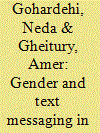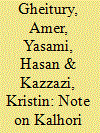| Srl | Item |
| 1 |
ID:
132101


|
|
|
|
|
| Publication |
2014.
|
| Summary/Abstract |
Focusing on four linguistic domains, purpose/manner of communication, preferring local dialects, politeness, and volume of use, this study aims to explore how gender is reflected in messages produced by Iranian female and male students. A corpus of 2,116 text messages was analyzed. Participants also filled out a questionnaire on how frequently they used text messaging. Results indicated females to be more prolific users of messaging. As far as function is concerned, while texts produced by females were for the most part relational, involving an emotional language, males frequently employed messages for informative-transactional functions which were less wordy and in more authoritative language. In addition, males were more likely than females to employ their local dialect and forms considered less polite.
|
|
|
|
|
|
|
|
|
|
|
|
|
|
|
|
| 2 |
ID:
098436


|
|
|
|
|
| Publication |
2010.
|
| Summary/Abstract |
Despite the great number of studies conducted by Western scholars exploring kinship terminologies in different languages, there seems to have been little attempt at dealing with kin words in Iranian languages like Kurdish. More specifically, Kalhori, as a southern dialect of Kurdish, has rarely been subject to studies of this nature. Underlining the significance of such studies in the wider linguistic and anthropological contexts, this study attempts to explore kin words Kalhori speakers use to refer to or address their relatives. We also make an attempt to investigate the possibility of presenting a formal explanation of the terms by placing them in a componential analysis framework.
|
|
|
|
|
|
|
|
|
|
|
|
|
|
|
|